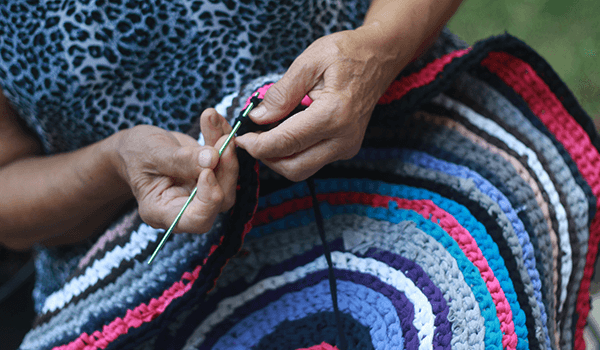February 14, 2023
Dementia: Fiber Arts to the Rescue

By Ram Rao, Ph.D., Principal Research Scientist for Apollo Health
Alzheimer’s disease (AD) is accompanied by structural and functional changes in specific brain areas, including a decrease in brain tissue, a reduction in blood flow, and a decline in communication between brain cells. All these changes can interfere with cognitive functioning, especially learning and memory.
Knitting and crocheting are both simple and complex tasks and, together, are great self-care tools for the craft artist. While the origins of knitting date back to the 5th century AD, one of the earliest pieces of evidence of crochet comes from South America, where a primitive tribe was said to have used crochet adornments for girls reaching puberty. Regardless of the origins of knitting and crochet, there are immense benefits to creating something attractive with sticks and strings. Both techniques are ‘simple’ in that they only require sticks and string and complex as well due to the endless possibilities of combined stitches and complicated design patterns such as those used when knitting lace. Knitting and crocheting can challenge and strengthen our brains by creating and repeating complex stitches and patterns.
Knitting and crocheting help build new neural pathways that help with memory and can reduce the cognitive decline that comes with age. In a 2011 study, researchers from the Mayo Clinic explored the mental activities of over one thousand people aged 70 to 89 that did not have a history of cognitive decline. The study found that those who engaged in crafts like knitting and crocheting had a diminished chance of developing mild cognitive impairment and memory loss. The researchers speculated that craft activities promote the rewiring of brain neural pathways that help maintain cognitive health.
Additionally, knitting and crocheting reduce stress and blood pressure, decrease symptoms of depression, and reduce chronic pain. The repetitive action of knitting and crocheting helps focus the mind, reducing anxiety and stress hormone levels. Several people explain that the mind stays focused and calmer when their hands are busy with these fiber arts. These subjective experiences are confirmed by research studies showing that clinically depressed people who resort to these skills feel pleased and can reduce their chronic pain experience. Dr. Herbert Benson, who wrote “The Relaxation Response,” says that the repetitive action of needlework can induce a relaxed state associated with meditation and yoga. Some people find that craftwork helps them control their weight. It may be that when the hands are holding needles and hooks, there’s less snacking and mindless eating. It also can create a feeling of satisfaction and accomplishment when a needlework project is completed.
According to the American Counseling Association, the easy and repetitive movements associated with knitting and crocheting can relax the body and mind to wind down enough to get to bed. And according to the Craft Yarn Council, these yarn skills require focus, concentration, and bilateral, coordinated hand and eye movements, all of which promote rewiring of the neural circuits, thereby improving memory. Given that social interactions also support health and longevity, those wishing to maximize their brain structure and function may consider joining a knitting or crocheting group. If you are associated with a group that donates the finished products to charity, there is a double benefit. In addition to engaging in selfless service, knitting for charity can reduce your stress levels while keeping your hands and mind active. There are so many benefits to these timeless fiber art practices that you might want to give them a try.




